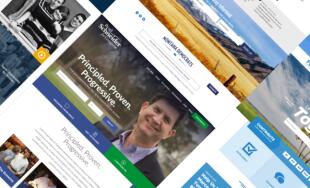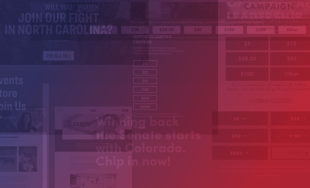Using Social Media in Political Campaigns

Since we do a lot of political website design, we frequently find ourselves helping candidates navigate the confusing landscape of social media. It’s a place where campaigns know they should be, but they don’t always know all of the nuances behind it. So, we’ve put together this multi-part series on using social media in political campaigns to help you effectively and efficiently leverage this exciting space.
Social Media has become the marketing strategy du jour for corporations and organizations of all sizes. From crowdsourcing vehicle designs to delivering excellent customer service, marketers are using social media in a variety of manners to derive input and value from their target.
Social Media also offers the rare example of a marketing strategy on which politics isn’t twenty years behind. Candidates and elected officials have been quick to adopt and leverage social media to engage and educate voters. For example, Barack Obama had dozens of social network profiles, ranging from MiGente.com to Facebook to BlackPlanet. However, as candidates continue to learn everyday, they’re not Barack Obama.
He was the once-in-a-generation-type candidate who had the type of celebrity appeal that made people excited to actually be his friend and network online with him. However, even though Obama is the exception and not the rule for extreme social media success, it doesn’t mean that your campaign can’t still have a formidable online presence that supports your offline efforts. It’s no secret that the campaign website is the hub of a campaign’s online activity, but social media are an important supporting cast that can drive valuable traffic to the site and engage voters on a more personal level.
This post, the first in the series, aims to educate campaigns on the most important social media and where you'll see the most bang for your buck.
What Social Media Should a Political Campaign Use?
This question is a difficult one to answer. When deciding how many social networks to join, it ultimately comes down to the candidate’s appeal and the campaign’s resources.
The number one rule is to not have any social media presence become a “ghost town,” meaning don’t join networks that you don’t have the available resources to update or be active in. It reflects horribly on a campaign to have a vacuous social network profile – a rarely update presence makes it appear that the campaign doesn’t value that network and its demographic while also suggesting that the campaign is more of a spammer than general conversation constructer.
While the first rule is to not overextend yourself into too many networks, that doesn’t excuse any candidate from not having a presence on at least a few of the top networks. We believe it’s absolutely necessary to have presences on at least: Facebook, Twitter, YouTube, and Flickr.
I like to call these networks the Big Four. They’re the fastest growing and farthest reaching of social networks; also, they represent four distinct ways of publishing to and connecting with voters.
- Facebook is comprehensive and allows you to post pictures, add videos, send detailed mass messages, publicly interact on Walls, and more.
- Twitter excels in short message bursts, event updates, blog post pushes, and breaking news. It allows a campaign to instantly send a succinct message to 1000’s of followers and also lets the campaign interact with other people in a one-on-one manner.
- YouTube is purely a video medium. However, its reach cannot be underestimated. The service’s search engine is second in use only to Google! This staggering number of searches makes it essential to own your candidate’s name for search on this platform.
- Flickr should be used to publish campaign photos. With more than 4 billion images and over 30 million monthly visitors, it’s an important place to be and exposes your campaign to an important network.
As you can see, each network is totally unique and allows you to connect with a huge audience. Voters expect every campaign to be on these media. In addition to simply having a presence on each of these networks, you should update them frequently and make sure that they are linked to from your main campaign website, allowing voters to easily get access and engage you in the different networks.
Depending on your campaign's message and target, other networks could also prove to be very useful. For a candidate with a strong business background, LinkedIn is a logical choice. For campaigns that are targeting an edgy or urban crowd, Myspace can still be a viable and effective network. There are dozens of other networks out there, with niche focuses ranging from veterans to volunteers.
If you have the available resources, the first networks to focus on after the "Big Four" are those focused on niches to which your candidate has specific ties. This strategy allows you to use natural synergies and capitalize on the base character of the candidate and campaign. No matter which networks you focus on though, it's important to never break the first rule by allowing any of your presences to become a ghost town.
This first post was more of a general overview. We invite you to stay tuned through our RSS feed or to join our Online Campaigning Linkedin group, where we hope these posts foster some creative and engaging conversation. Let us know your thoughts on social media and politics and any success you may have had in the comments.



Comments
Cynthia Beirut
Thank you Clay for this interesting article!Question please: if you were to launch a political party for multi-linguals nationals and a very large diaspora community, would you do one facebook page and post in different languages or several pages? one in english, one in arabic, one in franch then eventually spanish and protgueese? Here's the link to our website: www.partyoflebanon.com (almost finished in 4 languages) would love your feedback! Many thanks and sunny greetings from Beirut
Antionette Blake
As a SMM for a local politician, I appreciated these tips.investment with high return
Article Source: risk is unavoidable and this is true with financial trading,but with the use of w d gann intraday astrology - you can predict what
will happen even before you invest. Their portfolio is designed
for the long term, so it is able to manage the highs and lows of the market.
Most business owners understand the importance of an online presence.
travis
found this usefullLeave a comment